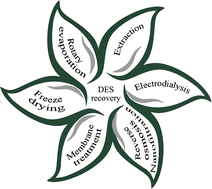DES: their effect on lignin and recycling performance
Abstract
Lignocellulosic biomass raw materials are renewable resources with abundant reserves in nature, and have many advantages, such as being green, biodegradable and cheap. Lignin, one of the three significant components of lignocellulose, possesses a chemical structure rich in phenylpropane and is a primary aromatic resource for the bio-based economy. For the extraction and degradation of lignin, the most common method is the pretreatment of lignocellulose with deep eutectic solvents (DES), which have similar physicochemical properties to ionic liquids (ILs) but address the disadvantages associated with ILs (DES have the advantages of low cost, low toxicity, and non-flammability). In lignocellulose pretreatment, a large amount of solvent is generally required to achieve the desired effect. However, after treatment, a substantial volume of solvent will be wasted, and thus, the problem of the recovery and reuse of DES solution needs to be adequately solved. The methods and mechanisms of perfect DES regeneration will be discussed from the perspective of the elemental composition and features of DESs in this review, which will also outline the present DES recovery methods, such as rotary evaporation, membrane separation, freeze-drying, electrodialysis, etc. The detailed process and the advantages and disadvantages of each method since 2018 are introduced in detail. Future DES recovery methods have been prospected, and the optimization of the functional properties of DESs after recovery is discussed. It is expected to find a convenient and efficient application method for DES extraction or degradation of lignin with low energy and low cost.

- This article is part of the themed collection: 2023 Reviews in RSC Advances


 Please wait while we load your content...
Please wait while we load your content...